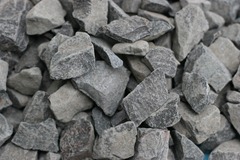HOW COARSE AGGREGATES AFFECT MIX DESIGN?
Coarse Aggregate Properties affecting Mix Design Strength
Maximum size of coarse aggregate:
Maximum size of aggregate affects the workability and strength of concrete. It also influences the water demand for getting a certain workability and fine aggregate content required for achieving a cohesive mix.

For a given weight, higher the maximum size of aggregate, lower is the surface area of coarse aggregates and vice versa. As maximum size of coarse aggregate reduces, surface area of coarse aggregate increases. Higher the surface area, greater is the water demand to coat the particles and generate workability. Smaller maximum size of coarse aggregate will require greater fine aggregate content to coat particles and maintain cohesiveness of concrete mix. Hence 40 mm down coarse aggregate will require much less water than 20 mm down aggregate. In other words for the same workability, 40mm down aggregate will have lower water/cement ratio, thus higher strength when compared to 20mm down aggregate. Because of its lower water demand, advantage of higher maximum size of coarse aggregate can be taken to lower the cement consumption.
Maximum size of aggregate is often restricted by clear cover and minimum distance between the reinforcement bars. Maximum size of coarse aggregate should be 5 mm less than clear cover or minimum distance between the reinforcement bars, so that the aggregates can pass through the reinforcement in congested areas, to produce dense and homogenous concrete.
It is advantageous to use greater maximum size of coarse aggregate for concrete grades up to M 35 where mortar failure is predominant. Lower water/cement ratio will mean higher strength of mortar (which is the weakest link) and will result in higher strength of concrete. However, for concrete grades above M40, bond failure becomes predominant. Higher maximum size of aggregate, which will have lower area of contact with cement mortar paste, will fail earlier because of bond failure. Hence for higher grades of concrete (M40 and higher) it is advantageous to use lower maximum size of aggregate to prevent bond failure.
Grading of coarse aggregate:
The coarse aggregate grading limits are given in IS 383 – 1970 – table 2, Clause 4.1 and 4.2 for single size aggregate as well as graded aggregate. The grading of coarse aggregate is important to get cohesive & dense concrete. The voids left by larger coarse aggregate particles are filled by smaller coarse aggregate particles and so on. This way, the volume of mortar (cement-sand-water paste) required to fill the final voids is minimum. However, in some cases gap graded aggregate can be used where some intermediate size is not used. Use of gap-graded aggregate may not have adverse effect on strength. By proper grading of coarse aggregate, the possibility of segregation is minimised, especially for higher workability. Proper grading of coarse aggregates also improves thecompactability of concrete.
Shape of coarse aggregate:
CoAse aggregates can have round, angular, or irregular shape. Rounded aggregates because of lower surface area will have lowest water demand and also have lowest mortar paste requirement. Hence they will result in most economical mixes for concrete grades up to M35. However, for concrete grades of M40 and above (as in case of max size of aggregate) the possibility of bond failure will tilt the balance in favour of angular aggregate with more surface area. Flaky and elongated coarse aggregate particles not only increase the water demand but also increase the tendency of segregation. Flakiness and elongation also reduce the flexural strength of concrete. Specifications by Ministry of Surface Transport restrict the combined flakiness and elongation to 30% by weight of coarse aggregates.
Strength of coarse aggregate:
Material strength of coarse aggregate is indicated by crushing strength of rock, aggregate crushing value, aggregate impact value, aggregate abrasion value. In Maharashtra the coarse aggregates are made of basalt rock, which has strengths in excess of 100 N/mm2. Hence aggregates rarely fail in strength. The IS limits for above tests are given below:
Aggregate Absorption:
Aggregate can absorb water up to 2 % by weight when in bone dry state, however, in some cases the aggregate absorption can be as high as 5%. Aggregate absorption is used for applying a correction factor for aggregates in dry condition and determining water demand of concrete in saturated surface dry condition.
Comments